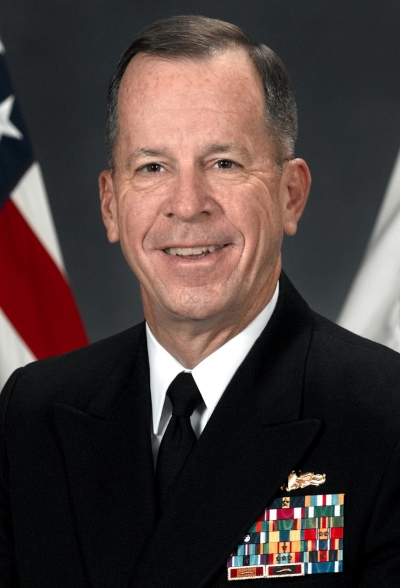Admiral Michael G. Mullen
Twenty-eighth Chief of Naval Operations
July 22, 2005–September 29, 2007
As a fleet officer, Admiral Michael G. “Mike” Mullen envisioned seapower as a show of force to deter terrorism or other acts of aggression. As Chief of Naval Operations, however, seapower began to take on a different meaning. It still included a strong forward presence in the blue waters and brown littorals, but it also included those serving on shore providing humanitarian aid or rebuilding infrastructure torn down by years of conflict.
As Admiral Mullen told students at the Naval War College in August 2005, the bigger picture relies on a “very different image of seapower” that includes “doctors and nurses healing the sick.” American warships may deter acts of violence, but it will be the service members providing aid who will change how Americans are perceived globally, Mullen explained in a 2006 interview with Seapower Magazine.
Just one month into his assignment as CNO, Hurricane Katrina made landfall in New Orleans with loss of life and property damage. On Admiral Mullen’s watch, the Navy dispatched Sailors, Seabees and more than 20 ships, including hospital ship USNS Comfort; provided medical services for the hurricane-stricken city; and oversaw search and rescue, search and recovery, and dive and salvage operations.
A bit further from home, Admiral Mullen was tasked with providing the forces and capabilities to support the combat missions in Iraq and Afghanistan. Admiral Mullen referred to the conflict in Iraq and Afghanistan as the “long war,” one that will be “generational,” with perhaps his grandchildren and even their children still fighting it.
Despite the strain on his current fleet in directly supporting two wars, his vision never waned. “I have three priorities … and they are to get it right for our people, operate our fleet and build the fleet for the future,” he said during an All Hands call at Naval Station Norfolk in May 2007.
As the United States continued fighting in ground wars, the Navy’s role became more expansive, and its definition of seapower evolved with mushrooming threats. According to Admiral Mullen, seapower was a “forward-deployed Navy, rotational and surge capable, in support of the joint force, large enough, agile enough, and lethal enough to deter any threat and defeat any foe.”
In January 2006 Admiral Mullen established the U.S. Navy Expeditionary Combat Command (NECC) to realign the existing expeditionary units under a single type command. NECC aimed to be more capable, responsive, and effective in responding to the requirements ordered by U.S. joint combatant commanders fighting terrorism and beyond.
Admiral Mullen also developed the Navy’s 30-year shipbuilding plan, which was designed to stabilize the fleet at 313 ships from 281 ships. The 2007 plan supported the Navy’s trend toward modernization and a larger force to carry on the fight against terrorism while remaining capable of providing humanitarian relief and deterring potential combatants in the maritime domain.
During his tenure as CNO, Admiral Mullen tasked the Naval War College with creating a new maritime strategy that addressed the challenges of the time and guided the Navy in an entirely new, globally connected environment. Representatives from the CNO’s staff and the Naval War College traveled throughout the country to facilitate the Maritime Strategy Symposium Series. This effort to define a new maritime strategy for the nation included involving American citizens through a series of public forums.
The maritime forces of the United States—the Navy, Marine Corps, and Coast Guard—came together to create the unified maritime strategy. A Cooperative Strategy for 21st Century Seapower was released under Admiral Mullen’s successor, Admiral Gary Roughead.
Michael Glenn “Mike” Mullen was born in 1946 in Los Angeles. He attended the U.S. Naval Academy as a recruited basketball player and graduated in 1968. In 1985 Mullen earned a master of science degree in operations research from the Naval Postgraduate School, and in 1991 he graduated from the advanced management program at the Harvard Business School.
As a junior officer, he served in various leadership positions aboard USS Collett, USS Blandy, USS Fox, and USS Sterett. Mullen commanded three ships: USS Noxubee, USS Goldsborough, and USS Yorktown. As a flag officer, he commanded Cruiser-Destroyer Group Two and the George Washington Battle Group. His last command at sea was as Commander, U.S. Second Fleet/Commander, NATO Striking Fleet Atlantic.
Shore assignments included Company Officer and Executive Assistant to the Commandant of Midshipmen at the U.S. Naval Academy. He also served in the Bureau of Naval Personnel as Director, Surface Officer Distribution and in the Office of the Secretary of Defense on the staff of the Director, Operational Test and Evaluation. On the Chief of Naval Operations’ staff, he served as Deputy Director and Director of Surface Warfare; Deputy Chief of Naval Operations for Resources, Requirements, and Assessments (N8); and as the 32nd Vice Chief of Naval Operations.
Before being named Chief of Naval Operations, Admiral Mullen’s final operational assignment was as Commander, Joint Force Command Naples/Commander, U.S. Naval Forces Europe. After two years as CNO, Admiral Mullen was sworn in as the 17th Chairman of the Joint Chiefs of Staff on October 1, 2007. He was nominated and confirmed unanimously for a second term, which began Oct. 1, 2009. Admiral Mullen retired on Sept. 30, 2011.
Explore more, click on the link for the CNO's baseball cards, here
Prepared for CNO and OPNAV Centennial Celebration, May 2015. Visit the Research section for additional information.



